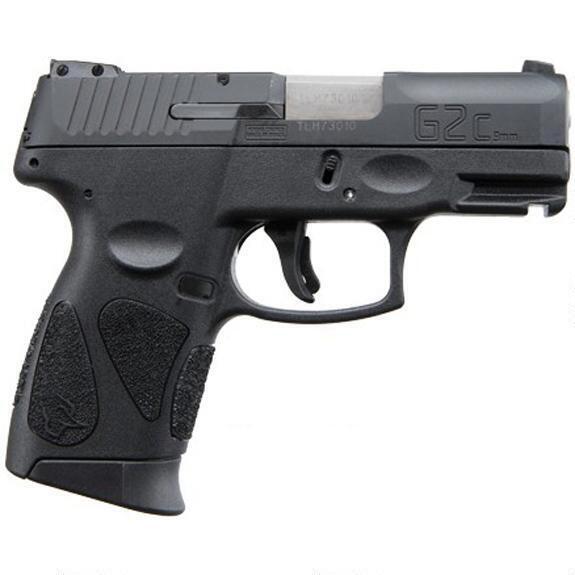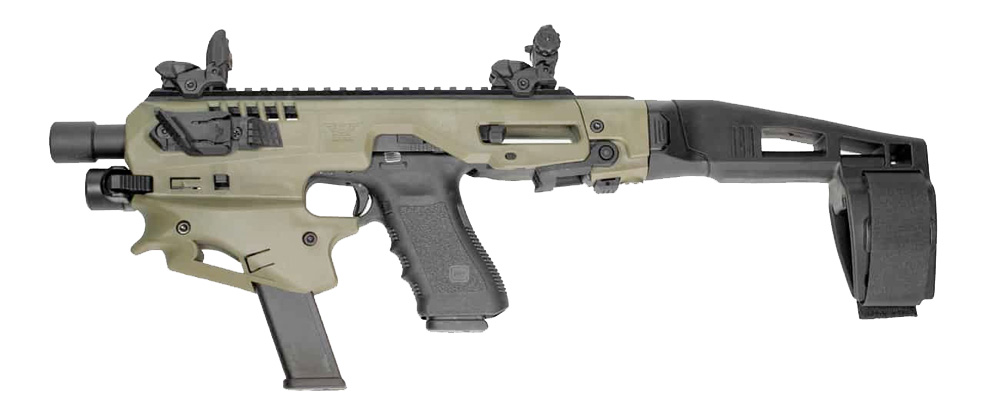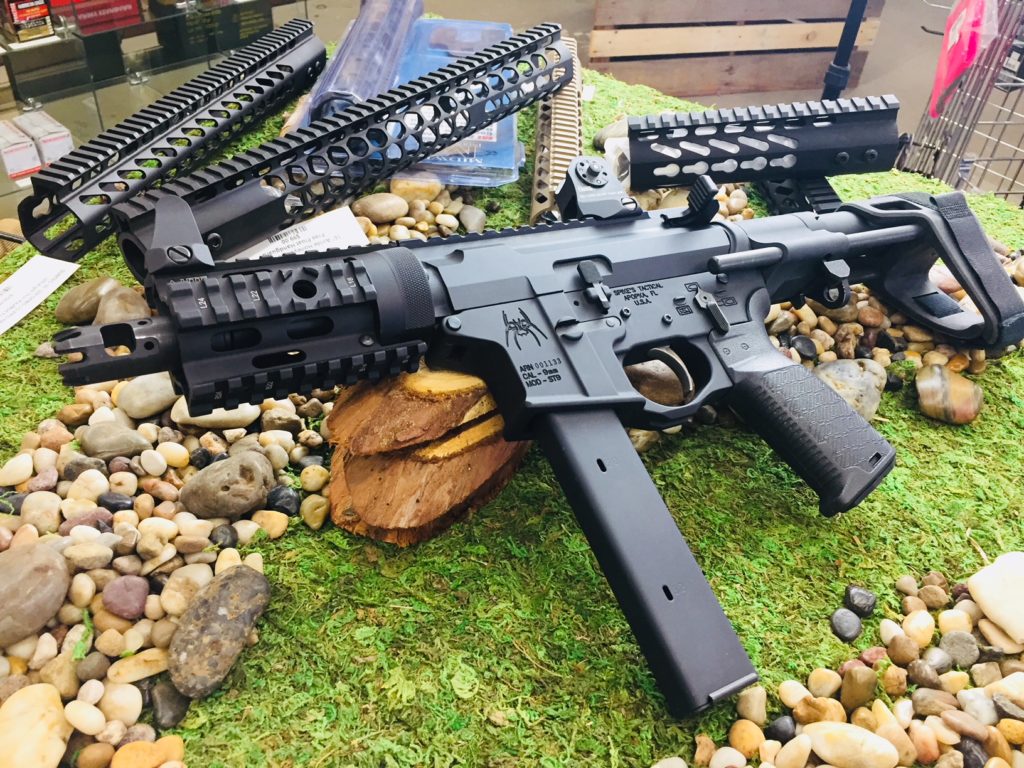If you keep up with the AR world, you’ve no doubt noticed a new movement taking hold…the rise of the AR-based Pistol Caliber Carbine (commonly called a “PCC” for short). They can also be referred to as an AR-9 or AR-45. In case you’re not familiar, the PCC is an AR-style firearm chambered in one of today’s popular pistol cartridges.
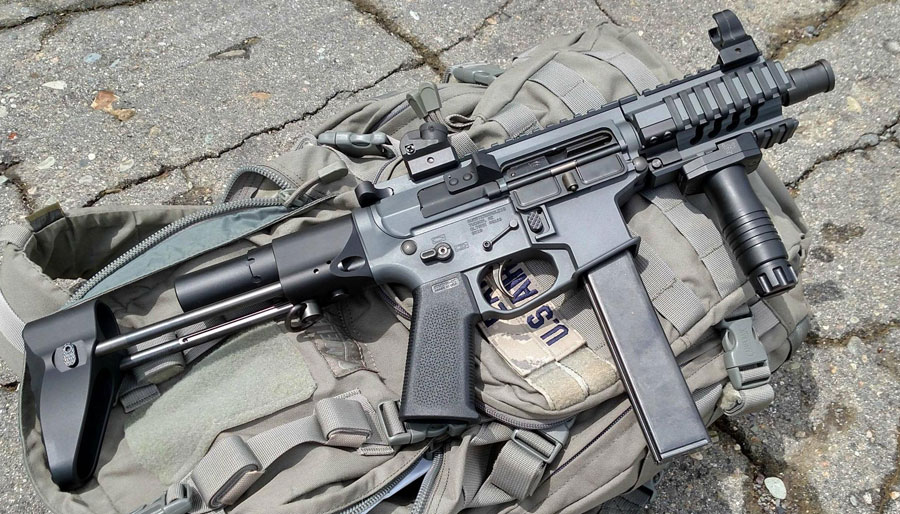
While conversion kits that allow for a standard AR-15 to fire pistol caliber rounds have existed for a while, the market is now seeing dedicated platforms that have been purpose-built to fire only pistol caliber rounds. The vast majority are 9mm but .40 S&W, .357 Sig, .45 ACP and even 10mm models and parts exist.
In the recent past, these dedicated pistol caliber AR components were mainly limited to handful of specialized manufacturers such as Angstadt Arms or Quarter Circle 10, but that is quickly changing. Having just returned from the annual SHOT Show in Las Vegas, it was quickly apparent that many of the big players in the AR manufacturing realm, from Spikes Tactical to CMMG to JP Enterprises, have either already added, or are soon planning to add pistol caliber options to their AR product lineup.
Instead of standard AR-15 magazines, most PCC receivers accept either Glock handgun magazines or Colt SMG-type magazines. While the Colt-compatible receivers are only available in 9mm, Glock receivers are available as either “Small Frame”, to accommodate magazines for calibers such as 9mm, .40 S&W or .357 SIG, or “Large Frame” which are sized for the more girthy magazines required for .45 ACP and 10mm.
Obviously their are a lot of advantages to being able to use these commonly available calibers and magazines. If you already own a Glock pistol, those same magazines you use in your everyday carry pistol could slide right into your Glock-compatible PCC and visa versa. PCCs share many of the same parts as standard AR-15s – handguards, upper receivers, buffer tubes and stocks, though some specific part considerations may be necessary, depending on the caliber.
So now with that little bit of education as to what they are, the question many might find themselves asking is why? Besides a slight reduction in ammo cost (depending on the caliber), why would someone need or want to shoot a pistol caliber out of an AR-15? If someone wants to fire handgun rounds, just shoot a handgun, right? Or if someone wanted a smaller AR, just build or buy an AR-15 pistol or SBR in 300 BLK. All good and relevant questions, but for certain applications and in specific configurations, a PCC can make a lot of sense for the average civilian shooter.
The Good About Pistol Caliber ARs
Size does matter. While anyone can certainly set up a rifle-sized AR firearm with a 16 inch barrel in a pistol caliber, I’ll be the first to agree that would seem to defeat the purpose.
Blowback = Short Barrel = Small Package
One of the key factors of these new PCCs is that instead of the traditional direct impingement or piston AR systems, they instead operate using blowback. Instead of gas being forced down a gas tube, the pressure within the chamber itself forces the bolt to cycle. With less concern for things like dwell time, and no need for gas blocks and tubes, the PCC can accommodate much shorter barrels than a standard direct impingement AR-15 setup. Some manufacturers are creating barrels as short as 3 inches, though most fall in the 4.5 – 8.5 inch range. Suddenly we’re no longer talking about a traditional looking AR-15 carbine that shoots pistol rounds, but something resembling a SMG-type firearm used by SWAT or special forces for close-quarters situations.
Optimal for Close Quarters
This where we believe the PCC really comes into its own. As a Personal Defense Weapon (PDW) for the average urban gun owner it gives the best of both worlds. You get the benefits of high ammunition capacity you’d normally only get with a full-sized AR carbine or rifle, without the same drawbacks inherent to shooting rifle calibers indoors and at close range.
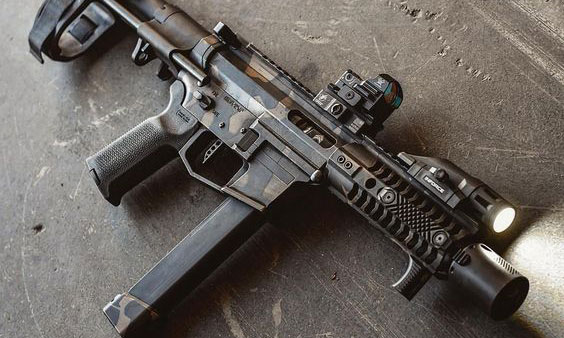
When it comes to shooting indoors, there is certainly such a thing as too much of a good thing. Obviously the first huge benefit to a pistol caliber round is a greatly reduced risk of over-penetration compared to some rifle calibers. While there is some argument as to the penetration characteristics of the 5.56-type round for home defense, one thing can’t be argued: most pistol rounds (especially subsonic) don’t reach the ear-bleeding decibel levels of a supersonic rifle cartridge.
One can add a suppressor to any caliber for noise reduction, but suppressor ownership is more of an exception than a rule. But even with a suppressor, the PCC would still generally be far more compact compared to a suppressed rifle caliber platform or even a standard AR pistol.
Outfit your PCC with a tactical light and red dot or reflex sight, and you’ve got a compact platform that’s light enough to be carried with one hand, leaving your other free to open doors, etc. That second hand can be then used to provide added stabilization when the time comes to pull the trigger. God-forbid, if ever in a scenario with multiple home invaders, the PCC would clearly give any defender an huge advantage compared to a standard handgun.
Versatility
Given its compact nature, the PCC can be stored in a relatively small space, also making it a good option for a vehicle. Widely available ammunition and compatible parts and magazines make it truly versatile firearm if you ever have to go on the road.
Ammunition Cost
And of course one of the biggest benefits of a pistol caliber AR is ammo cost. Let’s go back to the example I used about taking the subsonic 300 Blackout route instead, which ballistics show is similar to .45 ACP. So you’re basically getting similar results, but ammunition is going to be a magnitude more expensive. That’s not to say that 300 BLK is bad – there are certainly things a 300 BLK firearm can do can to that a PCC can’t – just that it’s a lot more expensive in relation to performance for this particular application. Things get much cheaper with 9mm. In other words, if your main mission for this type of platform is to have a home defense firearm, you’ll save a lot more money per round by going with a pistol caliber AR. Also, by choosing a PCC that shoots the same caliber as your handgun, you can further maximize your savings on bulk ammo vs spreading your purchase dollars around on several different calibers.
The Bad About Pistol Caliber ARs
All added up, there are a lot of good reasons to consider the PCC as an ideal option for many situations. But it’s not all sunshine and roses. There certainly are some cons to take into account when thinking about a PCC.
Component Cost
With PCCs being relatively new to the scene, the list of manufacturers turning out the dedicated parts needed to create this type of firearm is still relatively short when compared to standard AR parts. While more manufacturers are getting into the PCC market, the common theme is to start out making 9mm parts and components, as this seems to be the caliber of choice for the majority of early PCC adopters. Obviously makes perfect business sense, but if you would prefer your PCC in a different flavor, such as .45 acp, the choices become a lot more limited.
Of course that also leads to a supply and demand issue. While 9mm PCC parts are getting more and more affordable, it’s still a seller’s market when it comes to other calibers. Hopefully that will change over time, but if you’re wanting to keep your pistol caliber AR as budget-friendly as possible, 9mm is best option. Besides being a perfectly capable round for most defensive applications, it simply gives the builder the most component options at the best price right now.
Functionality Troubleshooting
That stuff mentioned earlier about not needing some of the direct impingement parts because pistol caliber ARs are blowback-operated? That also means one less variable that can be tweaked to ensure reliable operation. No adjustable gas blocks. If you’re pistol caliber AR isn’t cycling properly, the only things that can be tweaked on a blowback-operated AR without major changes are springs and buffer weights. A couple of manufacturers have created weight-adjustable bolts and buffers to help with fine-tuning, but as you can imagine, they command a hefty price tag.
NFA rules regarding short barreled rifles still apply, so if you’re hoping for an ultra-compact setup, you’ll need to make a donation to the federal government and wait for the SBR stamp. If that’s not a direction you want to go, a PDW brace like the one from SB Tactical or Matrix Arms can make a functional stand-in (until the ATF changes their mind). Otherwise any of the AR pistol braces, blades or bare buffer tube options are available.
Part Compatibility
As touched on earlier, some parts of a PCC can use standard AR-15 parts, but others require dedicated components. Obviously a caliber-specific barrel is required, but unlike a standalone interchangeable bolt paired with a standard carrier group of the AR-15, PCCs require a dedicated one-piece bolt/carrier for each caliber. This means that the ability to shoot multiple calibers easily from one lower, comes with a steeper price in a PCC. One other thing to keep in mind is that while a standard 5.56 Mil Spec upper receiver will work with a 9mm setup, an upper receiver with larger ejection port will be required for larger calibers. Differently weighted buffers can also be a necessity depending on the caliber.
NFA Weapons
Regardless of caliber, the BATFE designates rifles and pistols based on standard definitions. Care must be taken with carbines of any kind with barrels less than 16 inches to ensure they aren’t inadvertently creating what’s referred to as a short-barreled rifle or SBR. We’ve written an article describing these designations, and things one needs to keep in mind to stay on the right side of the law. You can read it here: AR-15 Rifle vs Pistol vs SBR. What’s the difference?
Final Pistol Caliber AR Thoughts
It may not be the perfect tool for every job, but the PCC can check a lot of boxes for the urban gun owner. It’s high-capacity magazines provide a boost in firepower over a traditional handgun, while being much more maneuverable than a rifle or shotgun in confined spaces. The risks of over-penetration associated with normal AR rifle calibers is greatly mitigated, making it a solid choice for home defense. For those who own a Glock pistol, their everyday carry gun and PCC PDW could possibly use interchangeable ammunition and magazines. With more and more manufacturers jumping on the bandwagon, the availability of components should grow as the prices decline.
JTAC offers pre-configured pistol caliber ARs, and we’re happy to custom build as well. We have access to hundreds of pistol caliber carbine parts and accessories from many manufacturers at wide-ranging price points. We really do have something for everyone. If you’re interested in starting a custom build, contact us today!





